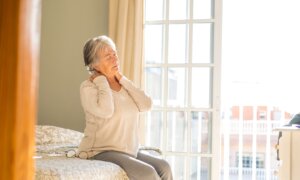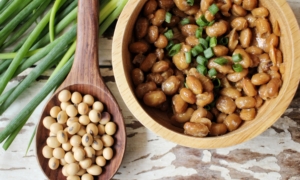The Yellow Emperor’s Internal Medicine, an ancient Chinese medical text, states, “One inch gain in the tendons prolongs life by ten years.” This gentle exercise of tendon stretching actually brings many benefits such as body shaping, fat loss, muscle strengthening, and better blood flow and meridian circulation.
Classical Chinese dance routines incorporate stretching exercises that develop muscle flexibility and aesthetic appeal. Wu Hongqian, a traditional Chinese medicine (TCM) physician at Yisheng Traditional Chinese Medicine Clinic in Taiwan and the author of the book “One Move to Stretch,” has analyzed the principles behind tendon stretching and its impact on muscles building and the health benefits that come with it.
While many people seeking muscle mass often turn to weight training, Wu suggests that mild stretching can achieve similar results. During an upward stretch, not only do the hands perform a pulling action, but the lower abdomen also exerts force to maintain an upright position. Adding tiptoeing engages the quadriceps, biceps femoris, and gastrocnemius muscles, effectively providing a full-body workout.
5 Benefits of Standing on Tiptoes
Standing on tiptoes is the best way to stretch the tendon along the legs, according to Wu. Regular practice offers five major benefits:
Strengthens the thigh and calf muscles
Tiptoeing calls into action the quadriceps femoris and biceps femoris muscles of the thigh and the gastrocnemius muscle of the calf.
Alleviates the chance of knee deterioration
Knee effusion is common among the elderly due to weakened muscles that struggle to drain fluid. Tiptoe training can enhance muscle strength, promote blood circulation, help drain knee fluid, and reduce the risk of knee degeneration.
Improves Achilles joint strength
Standing on tiptoes primarily involves the Achilles tendon of the ankle joint, which helps improve the strength and stability of the Achilles joint, reducing the risk of ankle sprains.
Triggers underfoot acupoint massage
Standing on tiptoes engages the plantar muscles, providing a form of foot massage. TCM believes that the internal organs of the human body have corresponding acupuncture points on the feet, which explains why standing on tiptoes can also indirectly promote general health.
Strengthens cardiac function
The calves are nicknamed “the second heart” due to their role in circulation. Exercising the calf muscles, such as by standing on tiptoes, can help pump blood back to the heart, thereby strengthening the function of the heart and making it healthier.
For beginners, Wu advises starting with a low tiptoe position and using a wall for support. Be careful not to turn the soles of your feet inward when standing on tiptoes. You can also wear ankle braces to keep your Achilles joints more stable.
Stretching for Body Shaping and Cramp Prevention
Muscle contraction during stretching helps burn excess fat, promoting slimming and aesthetic benefits. Even better is that you do not need to be in a gym to do that. This can be done leisurely, even while watching TV.
Additionally, stretching can reduce the frequency and severity of nighttime cramps.
Cramps may be due to muscle tightness, insufficient calcium ions, or nerve compression, Wu said. Stretching before bedtime can relax nerves, increase parasympathetic nerve activity, and facilitate easier sleep. For example, patients with sciatica are prone to night cramps because due to lumbar spine degenerates, which can compress nerves, causing body fluid to accumulate in the waist during sleep. A few rounds of gentle stretching can widen the joint cavity and reduce the pressure of body fluid on the nerves, thus reducing cramps in the middle of the night.
Classical Chinese Dance Stretching vs. Gym Weight Training
As a fitness coach, I believes that there are four principal differences between classical Chinese dance stretching and general gym weight training:
Muscle growth
Weight training sessions promote fitness gains by first breaking down muscle fibers and then repairing them with protein supplementation, which increases their strength and size. However, this method of muscle growth can easily cause fascial adhesion. So after weight training, many people need to do fascial release (applying pressure to the fascia to reduce pain and discomfort). In contrast, the stretching technique in classical Chinese dance is to first lengthen the muscles along their natural lines and then use body weight to strengthen these stretched muscles, providing a healthier approach to muscle growth.
Muscle shape
Weight training is effective for building large muscles. While these muscles tend to be strong, they may not be very extensive. In particular, training around the shoulder can easily lead to a shrugging posture. Conversely, the stretching exercises practiced in classical Chinese dance can build long, strong, natural muscles. TCM views ideal muscles as being both elastic and soft, rather than simply hard.
Exercise methodology
Weight training fitness sessions, say within a week, typically prioritize strengthening specific muscle groups, usually governed by training menus targeting a certain part of the body on different days. On the other hand, the stretching approach of classical Chinese dance takes a holistic view, engaging the entire body through movements that simultaneously work on multiple areas.
Practice time
Achieving a curvy physique or broad shoulders through weight training requires a significant time commitment in the gym, often daily. Although classical Chinese dance stretching also demands time to practice, the focus is on building natural muscles, which are the muscles that we use in daily life. With simple techniques, you can build muscles at any time.













